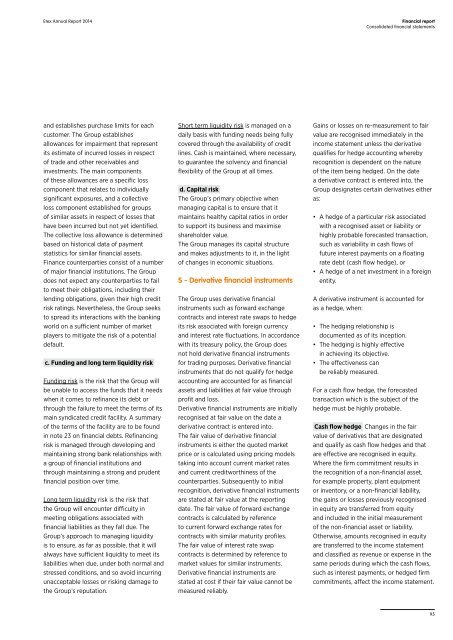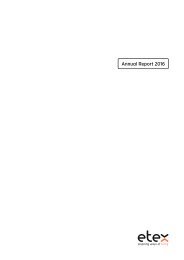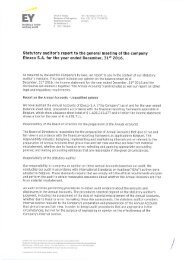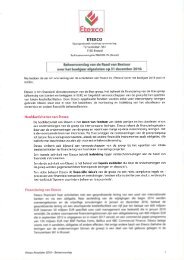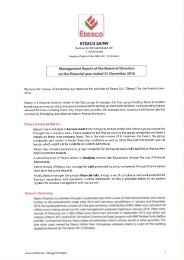Annual Report 2014
This is the 2014 annual report of Etex Group
This is the 2014 annual report of Etex Group
You also want an ePaper? Increase the reach of your titles
YUMPU automatically turns print PDFs into web optimized ePapers that Google loves.
Etex <strong>Annual</strong> <strong>Report</strong> <strong>2014</strong><br />
Financial report<br />
Consolidated financial statements<br />
and establishes purchase limits for each<br />
customer. The Group establishes<br />
allowances for impairment that represent<br />
its estimate of incurred losses in respect<br />
of trade and other receivables and<br />
investments. The main components<br />
of these allowances are a specific loss<br />
component that relates to individually<br />
significant exposures, and a collective<br />
loss component established for groups<br />
of similar assets in respect of losses that<br />
have been incurred but not yet identified.<br />
The collective loss allowance is determined<br />
based on historical data of payment<br />
statistics for similar financial assets.<br />
Finance counterparties consist of a number<br />
of major financial institutions. The Group<br />
does not expect any counterparties to fail<br />
to meet their obligations, including their<br />
lending obligations, given their high credit<br />
risk ratings. Nevertheless, the Group seeks<br />
to spread its interactions with the banking<br />
world on a sufficient number of market<br />
players to mitigate the risk of a potential<br />
default.<br />
c. Funding and long term liquidity risk<br />
Funding risk is the risk that the Group will<br />
be unable to access the funds that it needs<br />
when it comes to refinance its debt or<br />
through the failure to meet the terms of its<br />
main syndicated credit facility. A summary<br />
of the terms of the facility are to be found<br />
in note 23 on financial debts. Refinancing<br />
risk is managed through developing and<br />
maintaining strong bank relationships with<br />
a group of financial institutions and<br />
through maintaining a strong and prudent<br />
financial position over time.<br />
Long term liquidity risk is the risk that<br />
the Group will encounter difficulty in<br />
meeting obligations associated with<br />
financial liabilities as they fall due. The<br />
Group’s approach to managing liquidity<br />
is to ensure, as far as possible, that it will<br />
always have sufficient liquidity to meet its<br />
liabilities when due, under both normal and<br />
stressed conditions, and so avoid incurring<br />
unacceptable losses or risking damage to<br />
the Group’s reputation.<br />
Short term liquidity risk is managed on a<br />
daily basis with funding needs being fully<br />
covered through the availability of credit<br />
lines. Cash is maintained, where necessary,<br />
to guarantee the solvency and financial<br />
flexibility of the Group at all times.<br />
d. Capital risk<br />
The Group’s primary objective when<br />
managing capital is to ensure that it<br />
maintains healthy capital ratios in order<br />
to support its business and maximise<br />
shareholder value.<br />
The Group manages its capital structure<br />
and makes adjustments to it, in the light<br />
of changes in economic situations.<br />
S - Derivative financial instruments<br />
The Group uses derivative financial<br />
instruments such as forward exchange<br />
contracts and interest rate swaps to hedge<br />
its risk associated with foreign currency<br />
and interest rate fluctuations. In accordance<br />
with its treasury policy, the Group does<br />
not hold derivative financial instruments<br />
for trading purposes. Derivative financial<br />
instruments that do not qualify for hedge<br />
accounting are accounted for as financial<br />
assets and liabilities at fair value through<br />
profit and loss.<br />
Derivative financial instruments are initially<br />
recognised at fair value on the date a<br />
derivative contract is entered into.<br />
The fair value of derivative financial<br />
instruments is either the quoted market<br />
price or is calculated using pricing models<br />
taking into account current market rates<br />
and current creditworthiness of the<br />
counterparties. Subsequently to initial<br />
recognition, derivative financial instruments<br />
are stated at fair value at the reporting<br />
date. The fair value of forward exchange<br />
contracts is calculated by reference<br />
to current forward exchange rates for<br />
contracts with similar maturity profiles.<br />
The fair value of interest rate swap<br />
contracts is determined by reference to<br />
market values for similar instruments.<br />
Derivative financial instruments are<br />
stated at cost if their fair value cannot be<br />
measured reliably.<br />
Gains or losses on re-measurement to fair<br />
value are recognised immediately in the<br />
income statement unless the derivative<br />
qualifies for hedge accounting whereby<br />
recognition is dependent on the nature<br />
of the item being hedged. On the date<br />
a derivative contract is entered into, the<br />
Group designates certain derivatives either<br />
as:<br />
• A hedge of a particular risk associated<br />
with a recognised asset or liability or<br />
highly probable forecasted transaction,<br />
such as variability in cash flows of<br />
future interest payments on a floating<br />
rate debt (cash flow hedge), or<br />
• A hedge of a net investment in a foreign<br />
entity.<br />
A derivative instrument is accounted for<br />
as a hedge, when:<br />
• The hedging relationship is<br />
documented as of its inception.<br />
• The hedging is highly effective<br />
in achieving its objective.<br />
• The effectiveness can<br />
be reliably measured.<br />
For a cash flow hedge, the forecasted<br />
transaction which is the subject of the<br />
hedge must be highly probable.<br />
Cash flow hedge Changes in the fair<br />
value of derivatives that are designated<br />
and qualify as cash flow hedges and that<br />
are effective are recognised in equity.<br />
Where the firm commitment results in<br />
the recognition of a non-financial asset,<br />
for example property, plant equipment<br />
or inventory, or a non-financial liability,<br />
the gains or losses previously recognised<br />
in equity are transferred from equity<br />
and included in the initial measurement<br />
of the non-financial asset or liability.<br />
Otherwise, amounts recognised in equity<br />
are transferred to the income statement<br />
and classified as revenue or expense in the<br />
same periods during which the cash flows,<br />
such as interest payments, or hedged firm<br />
commitments, affect the income statement.<br />
95


